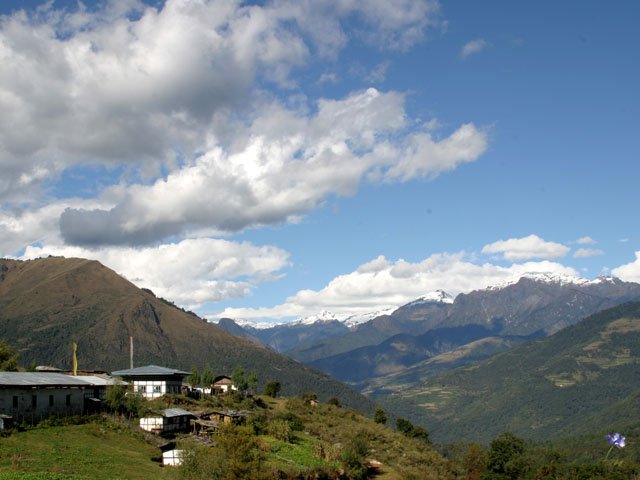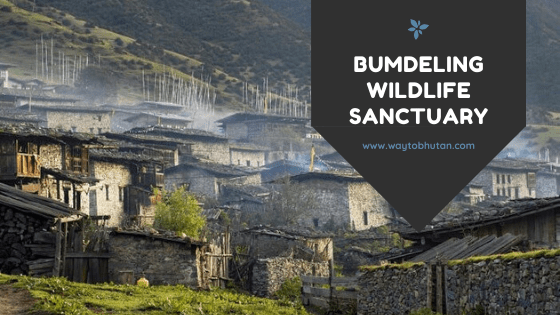Bhutan Govt. is very much concern about wildlife conservation. They don’t want to make dis-balance the Eco-system. In order to protect the ecosystems; about 26% of Bhutan consists of national parks, nature reserves, wildlife sanctuaries and conservation areas. The main ones are the Royal Manas National Park, Jigme Singye Wangchuk National Park (also known as the Black Mountains), Thrumshing La National Park, Jigme Dorji National Park, Bumdeling Wildlife Sanctuary, Kulong Chhu Wildlife Sanctuary, Khaling Wildlife Sanctuary, Toorsa Nature Reserve, Phipsoo Wildlife Sanctuary and Sakteng Wildlife Sanctuary. In addition, a further 9% of the country functions as a biological corridor, connecting protected areas. With 35% of the country being protected by some form of conservation management, the Bhutanese system for the conservation of biodiversity is globally unique.

About Bumdeling Wildlife Sanctuary
Located in North Eastern Bhutan, the Bumdeling Wildlife Sanctuary is an amalgamation of erstwhile Kulong Chhu Wildlife Sanctuary and the Bumdeling conservation area. Sharing international borders with China and India, it is encompassed within an area of fifteen square kilometers.
The Bumdeling Wildlife Sanctuary is one of the stunning landscapes of alpine meadows and encompasses gorgeous alpine lakes. Bumdelling conservation area was merged with Kulong Chhu Wildlife Sanctuary and therefore, was officially established in 1994. The Bumdelling Valley situated here is one of the two wintering spots for the Black Necked Crane.
It has a rich assortment of various species of flora and fauna, providing shelter to the Royal Bengal Tiger, Snow Leopard, Black Necked Cranes, White-Tailed Eagle, and many more. However, the most predominant feature of this sanctuary has to be the flutter of butterflies and more than two hundred species have been identified. The vegetation includes alpine meadows and pastures, pine forests to name a few.
The revision of Protected Area System in 1993, merged Kulong Chhu Wildlife Sanctuary and the Bumdeling conservation area and gazetted in 1994 to be called as Bumdeling Wildlife Sanctuary. It has an area of 1520.61 km2. It encompasses three Geogs in three different Dzongkhag viz. Bumdeling in Trashi Yangtse, Shermuhung in Mongar, and Khoma in Lhuntse. In the North, it shares international boundaries with China (Tibetan Province) and in the Northeast with India (Arunachal Pradesh). It forms an Eastern Himalayan Eco-region with a wide range of ecosystems ranging from warm-cool broadleaved forest to Alpine meadows. The vegetation types in Bumdeling Wildlife Sanctuary are Alpine scree slopes, Alpine pastures and meadows, Fir forest, Hemlock forest, Mixed and other conifer forests, Pine forests, Evergreen oak forest, Cool broad-leaved forest, Bamboo thickets, Alder forest, Warm broad-leaved forest, and Temperate pastures and meadows.

The Sanctuary is the catchments of the mighty Drangme Chu, one of the biggest rivers of Bhutan and the Kholong Chu , which forms the important habitat for the vulnerable Black-necked Crane in Bumdeling valley and also contributes to Kholong Chu hydro project.
A small area called Tobrang, close to the border of China is the only place where Ludlow’s Bhutan Swallowtail (Bhutanitis ludlowi) is found. The butterfly was thought to be extinct after its first discovery in 1933 and rediscovered in 2009. The butterfly is now the State Butterfly of Bhutan and endemic to Bumdeling Wildlife Sanctuary.
Villages and agricultural land in BWS are mostly located along the lower reaches of the Kulong Chhu and the Khoma Chhu. The villages at higher altitudes cultivate only on drylands, while in the lower villages both dry and wetlands are used for farming. Two small groups of yak-herders live in the northern parts of the sanctuary. The communities have the tradition of producing Dapa (wooden bowl) and Desho (handmade paper), Thangka (Buddhist Painted scrolls)and bamboo belts for weaving bamboo mats are of the worth mentioning local values of the Sanctuary that contribute to the local economy. The practice of Ridam and Ladam (restriction of entry into mountains and passes) by the communities residing in the Sanctuary, during certain months of the year to the core areas or the high altitude areas of the Sanctuary has helped to strengthen conservation, while also protecting the cultural heritage of the sanctuary.
Bumdeling valley offers wonderful surrounding to the visitors. The valley tells its own history of formation some 10,000 years ago due to the debris deposition. Though the valley looks isolated, the lush green surroundings is more appealing than all.
The reserve also serves to be of cultural and historical importance. It includes the Dechenphodrang Lhaghang, one of the most picturesque monasteries, and the Singye Dzong, adding to the rustic charm of the sanctuary. There are three rivers that flow through it and only add to the verdant surroundings. Also famous for its handicraft, the villagers thrive off of the handmade crafts particularly the wooden bowl (Dapa), handmade paper (Desho), Buddhist Painted scrolls (Thangka), and bamboo belts for weaving bamboo mats. The ideal time to visit this natural beauty would be from March till September but monsoons can be avoided.

The Wildlife Sanctuary covers an area of 1, 545 sq. km among which 1/3rd is occupied by human civilization. The villagers are sweet and friendly. The area is an idyllic ground for trekking as the routes are covered with lush meadows and towered by alpine forest.
Highlights: Cultural and heritage sites that have significance internationally; Known as the paradise of butterflies for it has more than 120 recorded species of Butterflies inhabiting there. Handicrafts such as wooden bowls, handmade papers, and Buddhist painted scrolls can be bought in the village
Location: North Easter Bhutan,
Best Season: March to September
Adopted from:
- Operator, B. T. (n.d.). Home. Retrieved from http://lomagutravels.com/about-bhutan/wildlife-in-bhutan/
- Bumdeling Wildlife Sanctuary, Bhutan. (n.d.). Retrieved from https://www.trodly.com/bhutan/destination-6327/bumdeling-wildlife-sanctuary
- Centre, U. N. E. S. C. O. W. H. (n.d.). Bumdeling Wildlife Sanctuary. Retrieved from https://whc.unesco.org/en/tentativelists/5700/





